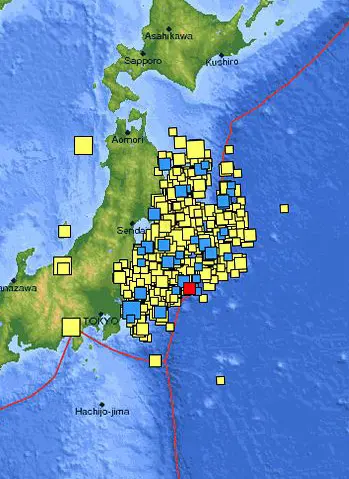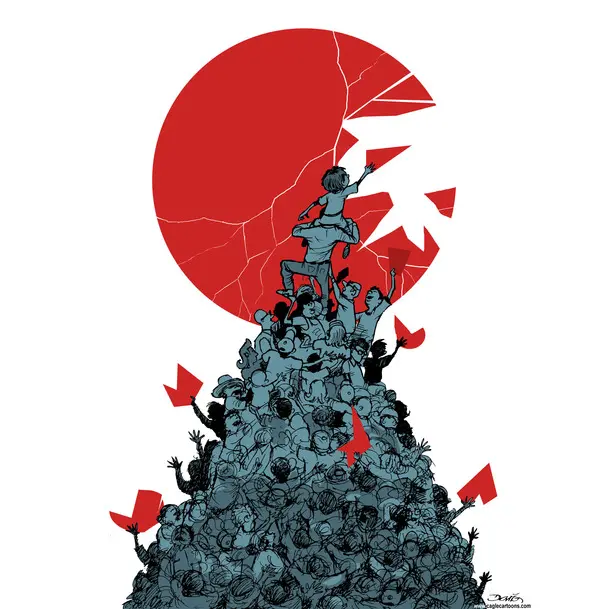Over the last week, Japan has been slammed with crisis. They were rocked with a 9.0 earthquake, followed by the resulting Tsunami, and currently trying to prevent a Nuclear meltdown from the damaged incurred by the earthquake and tsunami. I wanted to write something up real quick that a lot of links to video, photos, and other information about what's going on over there.
I've been keeping a close eye on everything as Japan is quite special to me. I have several friends living there, and I'm concerned about them. Also, because my brother and I had a vacation scheduled from March 24th through April 5th, and I was wondering how feasible it would be to continue with those plans. We have rescheduled our trip to sometime in May or June.
On March 11th, around 3pm local time, the 9.0 earthquake struck in the ocean about 100 miles east of Sendai, but the resulting aftershocks and several more earthquakes continued hours after the initial rumble. It is tied for the 4th largest earthquake ever recorded, and the largest recorded to hit Japan. USGS.gov has a list of all the earthquakes charted since March 11th, and it has a map of all the earthquakes, too.
http://earthquake.usgs.gov/earthquakes/recenteqsww/Maps/10/140_35_eqs.php
http://earthquake.usgs.gov/earthquakes/recenteqsww/Maps/10/145_40.php
Looking through the list there are 35 earthquakes that measured above a 6.0. 5 of the total amount of earthquakes happen inland, whereas all others happened in the ocean.
Associated Press Science has this to say about the 9.0 quake:
"The force of the quake was so strong that it moved the island of Honshu 8 feet to the east, said USGS geophysicist Ken Hudnut. It sped up the Earth's rotation by 1.6 microseconds, according to NASA."
http://hosted2.ap.org/APDEFAULT/386c25518f464186bf7a2ac026580ce7/Article_2011-03-11-US-SCI-Japan-Earthquake-Science/id-e9fbb5efba5c4974a96815053af9906f
Here's a few youtube links of some residents of in Tokyo neighborhoods experiencing the initial earthquakes: http://www.youtube.com/watch?v=VzAs8V9tLaI, http://www.youtube.com/watch?v=S9UQXw3nPUQ
Here's video of some building in Shinjuku swaying back and forth: http://www.youtube.com/watch?v=JhJzdtzl6KY
I'm not really sure if the earthquake alone did much massive damage. The quake did shut down several Nuclear reactors, but I think the major damage to the Fukushima reactor and the east coast of Japan was caused by the resulting Tsunami. Waves were apparently 30 feet high as they crashed into the coast.
Aerial video of the ocean water ravaging the country-side: http://www.youtube.com/watch?v=SQTJy5mWejA
Video of the water spilling into Miyako, Iwate: http://www.youtube.com/watch?v=5-zfCBCq-8I
And a massive whirlpool created by the moving waters: http://www.youtube.com/watch?v=rhCqf7M_tv4
The New York Times has an amazing page with images you can slide back and forth to see what the region looked like before the Tsunami hit, and after.
http://www.nytimes.com/interactive/2011/03/13/world/asia/satellite-photos-japan-before-and-after-tsunami.html?hp
The Atlantic's "In Focus" blog, and Boston Globe's "Big Picture" blog have had several entries this week about the earthquake, tsunami, and nuclear disasters
March 11th - In Focus - Earthquake in Japan
March 11th - The Big Picture - Massive earthquake hits Japan
March 12th - The Big Picture - Japan: earthquake aftermath
March 13th - In Focus - Japan Earthquake Aftermath
March 14th - In Focus - Japan Earthquake: Rescue, Recovery, and Reaction
March 14th - The Big Picture - Japan: Vast devastation
March 15th - The Big Picture - Japan: New fears as the tragedy deepens
March 16th - In Focus - Japan Earthquake: The Struggle to Recover
March 16th - The Big Picture - Japan: Continuing Crisis
Resources are at a minimum in Japan. Residents in northeastern Japan need electricity, water, food, shelter. One user on reddit wrote her account on what is going on in her town in Sendai: http://www.reddit.com/r/reddit.com/comments/g4snt/message_from_japan/
The massive earthquake and devasting Tsunami laid incredible damage to the Fukushima I Nuclear Power plant on the coast of the Pacific Ocean. I don't really know all the details on how a nuclear power plant works, and what they've been doing to contain it. Reddit user dwolf12345 posted an AMA since he's a reactor operator at a US plant very similar to Fukushima
http://www.reddit.com/r/IAmA/comments/g45ib/iama_reactor_operator_at_a_boiling_water_reactor/
"The fission reaction stops nearly instantly, however while the core is at power all the material in the core becomes INCREDIBLY radioactive. So after the fission reaction stops there is still considerable heat being generated due to radioactive decay of the fuel and other activated core components (this is called decay heat).
This is the heat that is causing the issues in Japan. It can take a day or two to cool the core down to below the boiling point even with good decay heat removal systems. As long as the vessel is kept full and the temperature brought down slowly and deliberately there is no issue at all. But take away that cooling system and the water it provides and you've got problems."
"It is very bad. No hyperbole there...nuclear plants NEED electrical power, even when shut down to ensure that the fuel stays cool. These plants were blacked out (no AC power) for 2-3 days. Normally losing off-site power is recoverable because of the on-site emergency diesel generators, however in this case they were swamped. In all likelihood they went without AC and DC power for a very long time. This means that any actions taken to stabilize the plant had to be manual(since there was no control power for remote controlling stations). They have gone deep down in their emergency plans, probably (although I am not sure of this) into their Severe Accident Management Guidelines. This means that they are beyond their design basis. Sort of into unknown territory, which is frightening to me.
Now I hear there is a fire on site and it may be threatening the spent fuel pool of one unit. This worries me more than the other issues right now. Spent fuel on the pool is within the secondary containment, but outside the primary containment. Needless to say it is HIGHLY radioactive. Assuming the primary containments hold at all the facilities, then the fuel pool is much more vulnerable and dangerous.
Keep in mind, these guys are in new territory here. They may have drilled and trained for these scenarios, but nothing ever goes exactly according to plan. I have much respect for the guys who are there and fighting this beast."
"First off this cannot be like Chernobyl as they are very different animals. Chernobyl actively exploded the reactor vessel. Chernobyl had no primary containment (by design), only a secondary containment structure. So when it blew the vessel head off, it and the steam plume blasted the building apart. Chernobyl fuel was open to the sky, no barrier at all between the public and the molten core of the reactor. That is why it spewed millions of curies of radioactive particulate into the sky.
There is a threat with the spent fuel pools. I don't know how much fuel they have in their pools, if any. If they do it is just as hazardous as what is in the core, with one exception. It is outside the primary containment structure. This makes it a little more worrisome in my opinion. I haven't heard much mention of the spent fuel pools at any of the affected units. I hope that is because everything there is under control. They do not require much cooling, because most of it has been removed from a core for a long time and has had many half-lives to decay away, so there is little decay heat. However, it is still quite radioactive.
The containment at Daiichi is much different than Chernobyl. Assuming that the fuel melted in all three of the affected reactors then there is still a very robust reactor vessel and a even more robust primary containment structure. Both are designed to be flood-able, and we know that they are filling up with borated seawater.
The name of the game now is cover and cool. This is what they are doing. I think there will be and has been release of radioactive materials, but so far they are keeping those cards close to the vest. I think in time it will be revealed to be orders of magnitude less than Chernobyl.
There is some news that Daiichi 2 has had a breach in the reactor vessel. That means that there is in all likelihood some fuel material out of the vessel and in the primary containment structure. Not time to panic yet, just need them to keep cooling that containment."
"Worst case...all the threatened containments fail and/or the fuel pools drain/collapse. The amount of radioactive material released is huge and we get an Asian version of Pripyat.
The reactors are shutdown now and they are getting water into the vessels (borated seawater). So, we are dealing with decay heat and it is not likely there will be a massive explosion a la Chernobyl, but the release could still be huge."
The Wikipedia entry for the Fukushima disaster is being updated constantly. Here's the article on the timeline of events: http://en.wikipedia.org/wiki/Timeline_of_the_Fukushima_nuclear_accidents
That also shows that NISA rates this as a Level 4 nuclear disaster, whereas ASN rates it as Level 6. Here's the International Nuclear Event Scale explaining those levels: http://en.wikipedia.org/wiki/International_Nuclear_Event_Scale
Also, in you're wondering, they are about 15 nuclear power sites across Japan housing 55 nuclear reactors. http://en.wikipedia.org/wiki/Nuclear_power_in_Japan
Several of the northeastern plants have been shut down automatically from the tremors. As such, Japan is operating under a huge power loss. They have dimmed down electricty in Tokyo is conserve as much power as possible. They have also roaming scheduled blackouts to keep the electrical output needed at a minimum.
Eva Geeks comments that there's a grassroots movement of nerds to dub these blackouts and brownouts after an event that happens in the Evangelion television show and movies, entitled Operation Yashima. In the show, Japan consolidates all of the energy output of their nation to fire a cannon against the alien threat. http://www.evageeks.org/2011/03/operation-yashima-website/
As far as news sources, I've been paying attention to reddit and Google News for new information and sifting through it to find the relevant news.
Google has an amazing map showing the devastation: http://maps.google.com/maps?ftr=crisisresponse.kmlpanel:src=japan_earthquake_2011&cad=japan_earthquake_2011
Also, be sure to Donate!! Japan's resources are stretched thin and need all the support they can get!! Google has a great landing page for how to contribute: http://www.google.com/crisisresponse/japanquake2011.html
The Nuclear crisis is a continuing concern, but citizens have already started banding together to preserve and rebuild their country. Good luck!
